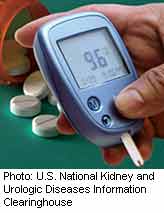
MONDAY, March 14 (HealthDay News) — Although there are numerous options in oral medications for type 2 diabetes, an older drug — metformin — may be the best first-line option, according to a new analysis of research on diabetes medications.
The analysis included six classes of oral diabetes medications, and found that all of them lower blood sugar levels by a similar amount. The authors suggest that metformin is probably the best first-line choice because it has fewer side effects than other drugs and, because it’s an older medication and available in a generic form, it also costs less.
“Metformin continues to be an inexpensive medication and it’s very efficacious,” said the study’s lead author, Dr. Wendy Bennett, an assistant professor of medicine at Johns Hopkins University School of Medicine in Baltimore.
Nearly 26 million Americans have diabetes, according to the U.S. Centers for Disease Control and Prevention. Untreated, diabetes can lead to numerous complications, including kidney disease, eye disease, heart problems and amputations.
There are 11 classes of diabetes medications that are approved to treat high blood sugar in people with type 2 diabetes in the United States. Nine of these classes of medications have been available since 1995, according to background information in the study, which was led by researchers at Johns Hopkins University, along with researchers at Case Western Reserve University in Cleveland, Ohio, and the University of North Carolina at Chapel Hill.
Most people with type 2 diabetes need to take more than one medication to adequately control their blood sugar levels, the study authors noted.
The most common serious side effect from any of these blood sugar-lowering medications is hypoglycemia, or low blood sugar levels. Other common side effects include gastrointestinal problems, such as nausea or diarrhea. Bennett said that these side effects can be minimized by starting with a lower dose of medication initially and taking it with a meal.
The researchers, who were supported by the U.S. Agency for Healthcare Research and Quality, reviewed a total of 166 studies for the current analysis. The studies included six classes of medication: metformin (Glucophage, Fortamet and others); sulfonylureas (Amaryl, Glucotrol and others); thiazolidinediones (Avandia and Actos); meglitinides (Starlix and Prandin); DPP-4 inhibitors (Januvia and Onglyza); and GLP-1 receptor agonists (Byetta and Victoza).
In general, most of the medications lowered hemoglobin A1C levels (a measure of long-term blood sugar control) by one percentage point. The American Diabetes Association recommends that most people with diabetes keep their A1C levels below 7 percent, so a drop of one percentage point is clinically meaningful.
The researchers also found that adding a second medication improves blood sugar control, but that no combination of medications appeared to offer significant benefits over another.
Metformin, which was associated with an increased risk of diarrhea, appeared to have the lowest side-effect profile, according to the analysis. And, it also cost the least, according to the report. Metformin costs about $0.35 per pill compared to $6.42 for Januvia, according to the study authors.
As a class of medications, thiazolidinediones, which include Actos and Avandia, have come under intense scrutiny because of serious potential side effects, and this analysis confirmed that weight gain, fractures and an increased risk of congestive heart failure are associated with thiazolidinediones. Although heart attacks have also been linked to the class of medications, this analysis was not able to confirm or refute an increased risk of heart attack, according to Bennett.
Sulfonylureas and meglitinides were associated with an increased risk of hypoglycemia, the study noted.
The study, which reviewed 140 randomized controlled trials and 26 observational studies, noted that 95 reported pharmaceutical company support. In addition, most lasted no more than two years and generally excluded people with type 1 diabetes, those with serious co-existing conditions and those of older age.
Results of the study are published in the March 15 issue of the Annals of Internal Medicine.
Dr. Joel Zonszein, director of the Clinical Diabetes Center at Montefiore Medical Center in New York City, said this study doesn’t offer much new information.
“As is well known, most medications lowered A1C similarly. The question is what medication to use in what patient population? A one-size-fits-all approach is the wrong approach,” said Zonszein.
“There is tremendous patient variability. Some people have a great response [to certain medications], some have none. What we need are studies sponsored by the National Institutes of Health, not pharmaceutical companies, so that we can learn better how to use these drugs in combination,” he added.
More information
Learn more about the different types of oral diabetes medications from the American Diabetes Association.

